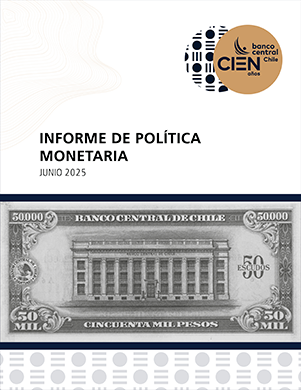Monetary Policy Report June 2025
Monetary Policy Report June 2025

The external macroeconomic scenario has become considerably more uncertain. Part of this is due to the changing announcements about U.S. trade policy and its implications. Although the impacts of this situation on global activity are not yet evident, expectations are that they will be negative. Its magnitude is expected to be greater in the United States than in the emerging world, since, in contrast to other episodes of uncertainty, financial conditions have responded favorably. More recently, an escalation of military conflicts in the Middle East has added, which scope, development and possible impacts on the global and Chilean economies are unknown. At the local level, activity was more dynamic than anticipated in the first quarter, supported by some temporary elements. Inflation has evolved in line with expectations and the upward risks that had been highlighted in the first part of the year have moderated. The central projection scenario shows no major changes. GDP is still estimated to evolve around its trend in the coming quarters, while inflation is foreseen to converge to 3% during the first half of 2026. Over the medium term, the escalating trade conflict will continue to affect the economic outlook. Furthermore, recent events in the Middle East introduce a new source of uncertainty, which could develop into more complex scenarios. However, if the central scenario of this IPoM materializes, in the following quarters the Monetary Policy Rate (MPR) will be approaching its range of neutral values. The Board will assess the future movements of the MPR considering the evolution of macroeconomic conditions and their implications for the convergence of inflation.
What does this MP Report tell us?

The trade war has increased uncertainty in the global economy, but so far it hasn’t had a major impact on our country.

The trade war has increased uncertainty in the global economy, but so far it hasn’t had a major impact on our country.
- The United States government announced significant changes to tariffs, although these announcements have been modified several times.
- Added to this is the development of the armed conflict between Israel and Iran.
- According to the updated data available, no major changes are observed in Chilean foreign trade.
- In any case, there is consensus that the U.S. will be the country that will receive the main effects on its prices and economic activity.

So far this year, the Chilean economy has performed better than expected, partly due to temporary factors.
- The increased dynamism was mainly due to the growth of the export sectors.
- However, these factors are projected to dissipate during the remainder of the year.
- In any case, and given the better result at the beginning of the year, the growth range forecast for the Chilean economy in 2025 is 2.0-2.75% (1.75-2.75% in March).

Inflation has decreased and will reach the target in the first half of next year.
- Price increases have been lower, as expected, and upside risks have moderated.
- Inflation is currently at 4.4%, above the 3% target, which will be reached in 2026.
- Chile imports a significant number of Chinese products, some of which are expected to see price declines due to trade diversions (when countries send their products to a different market than usual).

The Central Bank will continue to closely monitor the evolution of the global and national economy because controlled inflation contributes to the well-being of all the country’s inhabitants.
- In the medium term, the trade war and rising geopolitical tensions will continue to affect the economic scenario, so risks are high.
- While the Chilean economy is not isolated from what happens abroad, it is prepared to mitigate the impacts of possible new events.
- In case of any eventuality, the monetary policy rate (MPR) has room for adjustments to ensure inflation convergence to the 3% target.
Presentations
Presentation by Rosanna Costa, Governor, before the Finance Commission of the Honorable Senate of the Republic
- Presentation by Rosanna Costa, Governor, before the Finance Commission of the Honorable Senate of the Republic
- Presentación de Rosanna Costa, Presidenta (Icare)
- Presentación de Claudio Soto, Consejero (El Mercurio Antofagasta)
- Presentación de Rosanna Costa, Presidenta (Universidad de Los Andes)
- Presentación de Claudio Soto, Consejero (U. SEK)
- Presentación de Elías Albagli, Gerente de la DPM (PUC)
- Presentación de Alberto Naudon, Consejero (U. Autónoma)
- Presentación de Luis Felipe Céspedes, Consejero (Cámara Regional del Comercio de Valparaíso)
